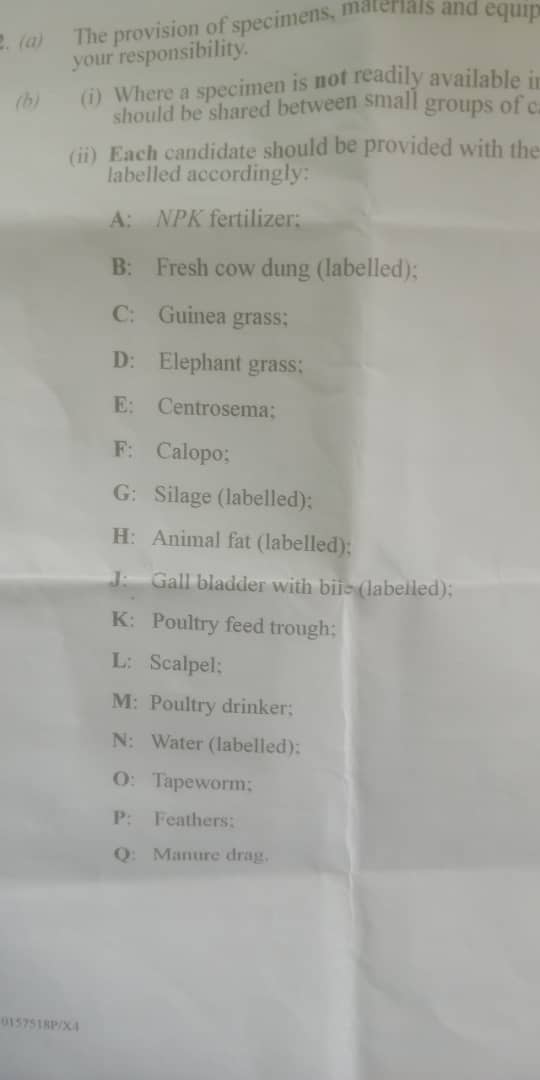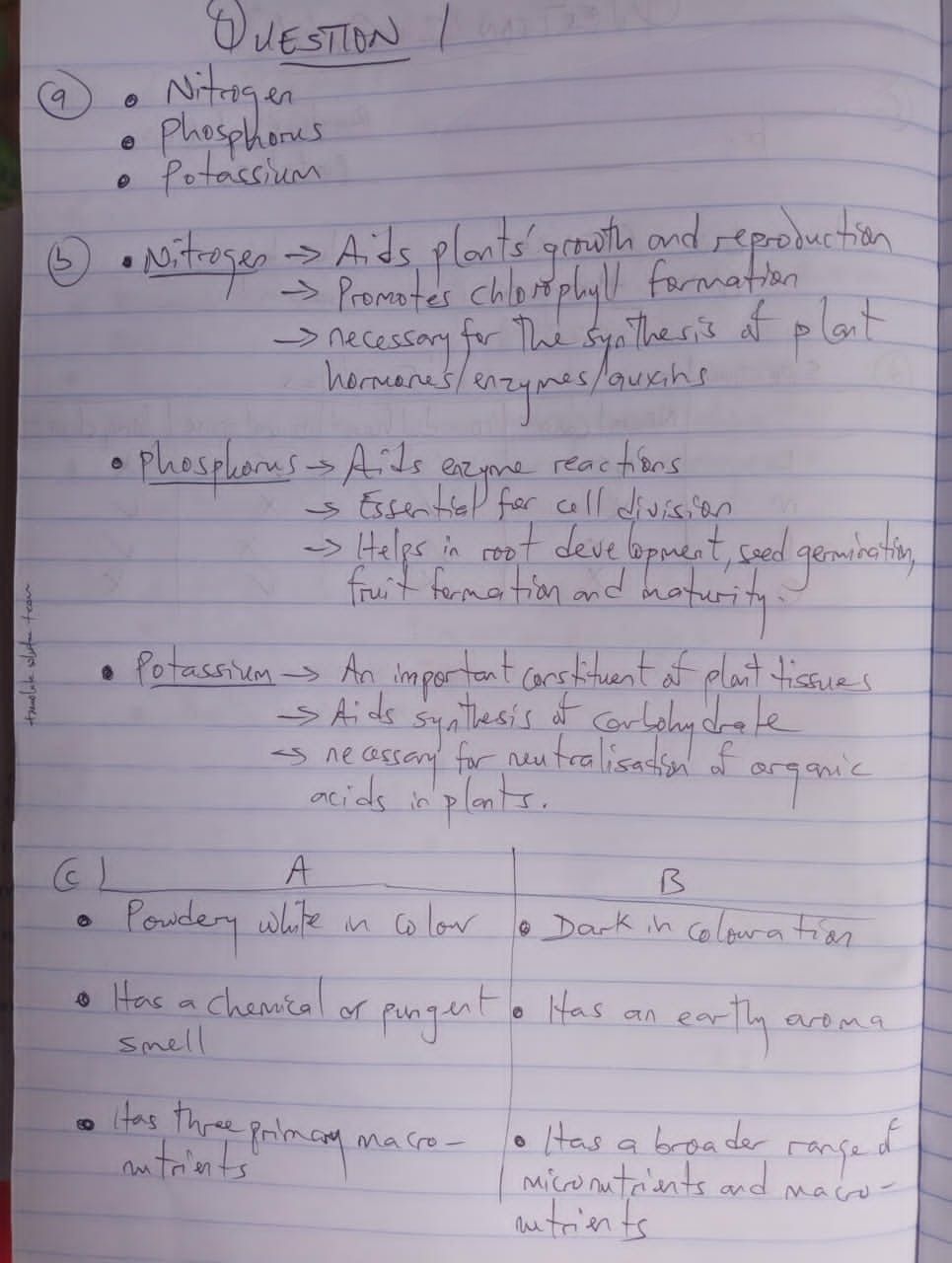Join Our Telegram Channel
Join Our Whatsapp Group
Wednesday, 29th May 2024
Animal Husbandry (Alternative B) 3 (Practical) 9:30am – 11:00am (1st Set)
Animal Husbandry (Alternative B) 3 (Practical) 11:30am – 1:00pm (2nd Set)
(1)
(2a)
(i) Specimen C: Panicum maximum
(ii) Specimen D: Pennisetum purpureum
(iii) Specimen E: Centrosema pubescens
(iv) Specimen F: Calopogonium mucunoides
(2b)
(PICK ANY FOUR)
(i) It is a legume that fixes nitrogen, enriching the soil for other plants.
(ii) It is a valuable forage crop, providing high-quality protein for livestock.
(iii) It is relatively drought-tolerant, making it suitable for areas with limited water supply.
(iv) It is easy to establish and maintain, requiring minimal care.
(v) It is a palatable forage crop, readily consumed by livestock.
(vi) Its nitrogen-fixing ability and leaf litter improve soil fertility, benefiting other plants in the pasture.
(2c)
(i) Choose suitable forage crops and harvest at the right maturity.
(i) Chop the forage into small pieces.
(ii) Wilt the forage to reduce moisture if needed.
(iii) Transport and fill the silo quickly.
(iv) Compress the forage to expel air.
(v) Seal the silo with plastic sheets or airtight materials immediately.
(vi) Allow the forage to ferment anaerobically for several weeks.
(3a)
(PICK ANY TWO)
(i) Fatty acids
(ii) Glycerol
(iii) Energy (ATP)
(iv) Triglycerides (stored in adipose tissue)
(v) Cholesterol
(3aii)
(PICK ANY THREE)
(i) Overfeeding the animals with high-fat and carbohydrate-rich diets can cause fat accumulation.
(ii) Limited movement or exercise can result in energy not being expended, leading to fat buildup.
(iii) Genetic predisposition in certain breeds can lead to higher fat accumulation.
(iv) Diets rich in calories, especially from grains and commercial feed, contribute to fat buildup.
(v) Hormonal imbalances, such as hypothyroidism, can reduce metabolic rates and lead to fat accumulation.
(vi) Older animals tend to accumulate more fat as their metabolism slows down.
(3b)
(PICK ANY TWO)
(i) Contamination with bile which can lead to a bitter taste in the meat, making it unpalatable.
(ii) It leads to discoloration of meat
(iii) It will increase the bacterial load leading to faster spoilage of the meat.
(vi) Bile’s upleasant odour will make the carcass less desirable to consumers.
(3c)
K:
(PICK ANY ONE)
(i) To provide a designated place for feeding chickens or other poultry
(ii) To minimize feed contamination
M:
(PICK ANY ONE)
(i) It is used to provide a clean and consistent water supply to poultry
(ii) It helps maintain hygiene by ensuring that water is kept clean and free from contamination
(3d)
K
(PICK ANY TWO)
(i) Ensure the feed trough is cleaned regularly to remove leftover feed, dust, and debris
(ii)Frequently inspect the trough for any signs of damage, such as cracks or sharp edges.
(iii) Periodically disinfect the feed trough using a safe, non-toxic disinfectant to kill any bacteria or pathogens that could harm the poultry.
(iv) Ensure the trough is placed at an appropriate height and location to prevent contamination by feces and minimize spillage
M
(PICK ANY TWO)
(i) Clean the drinker daily to ensure that the water remains fresh and uncontaminated
(ii)Regularly inspect the drinker for leaks or cracks.
(iii) Periodically disinfect the drinker using an appropriate disinfectant to eliminate any harmful pathogens
(iv) Ensure that the drinker is always adequately filled with clean water.
(3e)
(PICK ANY TWO)
(i) Rivers
(ii) Streams
(iii) Ponds
(iv) Lakes
(iii) Water wells
(4ai)
Humans
(4aii)
Pigs
(4bi)
(PICK ANY FOUR)
(i) Regular deworming
(ii) Proper sanitation and hygiene
(iii) Avoiding feeding uncooked or contaminated food
(iv) Treating infected animals promptly
(v) Rotating pastures to prevent re-infestation
(vi) Inspecting and managing intermediate hosts (e.g., control of fleas and lice)
(4bii)
(PICK ANY TWO)
(i) Weight loss
(ii) Diarrhea
(iii) Abdominal pain
(iv) Nutrient deficiency
(4c)
(PICK ANY FIVE)
(i) It is used in bedding and insulation
(ii) It is used as fashion accessories and clothing
(iii) It serves as craft and decorative items
(iv) It is used as writing instruments (quills)
(v) It is used in religious and cultural ceremonies
(vi) It is used as stuffing for pillows and mattresses
(vii) It is helpful in scientific research and educational purposes
(4d)
(PICK ANY TWO)
(i) It is used for collecting and removing manure
(ii) It is used for spreading manure as fertilizer
(iii) It helps in maintaining clean and hygienic animal housing
(iv) It helps in preventing the spread of diseases
(v) It helps in enhancing pasture and soil quality through manure management
COMPLETED!!




SPECIMENS:

